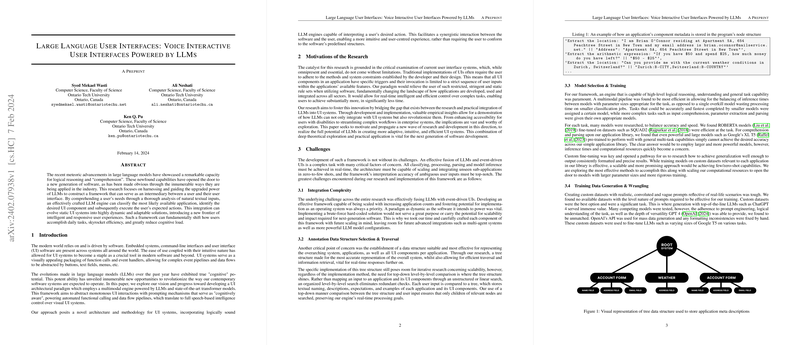Transforming User Interfaces with LLMs
Introduction
Ever found yourself struggling with a complicated user interface (UI) while trying to complete a simple task? The paper we're exploring today proposes a fascinating solution to this problem by utilizing the power of LLMs. The central idea is to create a framework where LLMs can seamlessly interpret user inputs and control various UI elements, making software interactions much more intuitive and user-friendly.
Motivations Behind the Research
Current UI systems are heavily dependent on predefined sequences of user inputs, which can be restrictive and sometimes frustrating. This research aims to change that by integrating LLMs into UI systems, enabling real-time, intelligent interactions. The potential benefits range from making software more accessible to streamlining complex workflows in enterprise settings.
Key Challenges
Creating such an advanced framework comes with its own set of hurdles:
Integration Complexity
Merging LLMs with traditional event-driven UIs is not a straightforward task. The framework needs to be scalable and flexible to accommodate various applications and UI components. A brute-force, hard-coded approach wouldn't be effective, so meticulous planning was essential.
Data Structure for UI Components
Representing the entire system, including applications and UI components, required a suitable data structure. The authors settled on a tree structure that allows for efficient traversal and real-time responses.
1 2 3 4 5 6 7 |
{
"Weather": {
"AppName": "Weather",
"Description": "A sub-node of Weather. Represents the point where location or query details are input for weather-related inquiries.",
"Parameters": { "City": "What is the location?"}
}
} |
Model Selection and Training
The framework required an engine capable of high-level reasoning and understanding. A multimodal pipeline using models like ROBERTA and T5 was employed to handle different tasks, ensuring a balance between accuracy and speed.
Proposed LM-UI Integration Framework
The core of this new UI paradigm is a hybrid design that combines annotated front-end components with a powerful LLM engine.
Modelling UI Controls
UI elements are treated as states that can dynamically respond to natural language inputs. Meta descriptions and example questions are used to guide the LLM engine in interpreting user actions.
1 2 3 4 5 |
{
"Name": "Connor Syle",
"Address": "34 Coronation Street",
"Email": "[email protected]"
} |
Data Flow and State Management
The framework uses a Redux store to manage states. When a user input is received, it's processed by the LLM engine, which then updates the central store, triggering UI updates accordingly.
Practical Applications
The researchers demonstrated this framework with applications like account sign-up forms, weather queries, and calculators. This serves as proof of concept and illustrates the framework's potential for more complex applications in the future.
LLM Engine
The LLM engine follows a sophisticated pipeline for processing user inputs, which includes:
- Tokenization: Breaking down the input into tokens.
- Token to ID Conversion: Mapping tokens to IDs.
- Segment and Positional Embeddings: Adding contextual information.
- Parameter Extraction: Using models like Google's T5 to match user inputs with application requirements.
Model Performance
The paper evaluated several models, finding that the custom-trained T5 model generally outperformed others in tasks like weather queries and account form filling.
Evaluation
Accuracy in parsing and classifying user inputs was the key benchmark. The framework showed strong performance, especially with the custom-trained T5 model.
Future Directions
The framework opens up numerous avenues for future work:
- Automated UI Generation: Automating the creation of UI components from textual descriptions could significantly simplify development.
- Enhanced LLM Engine: Exploring configurations that balance task delegation and model performance can improve accuracy and speed.
- Concurrent Processing: Scaling up to handle large-scale concurrent processing of user requests could make the framework robust enough for widespread adoption.
Conclusion
This paper outlines a compelling vision for the future of user interfaces, leveraging the latest advancements in LLMs. By making software interactions more dynamic and intuitive, this research could pave the way for the next generation of user experiences. The practical applications are vast, from enhancing everyday software tasks to making high-stakes enterprise workflows more efficient. The journey from traditional, static UIs to intelligent, responsive systems appears more achievable than ever, thanks to these innovative strides in the field.
